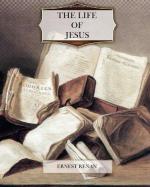[Footnote 2: Matt. vii. 22, x. 1; Mark iii. 15, vi. 13; Luke x. 17.]
[Footnote 3: Matt. xvii. 18, 19.]
[Footnote 4: Mark vi. 13, xvi. 18; Epist. Jas. v. 14.]
[Footnote 5: Mark xvi. 18; Luke x. 19.]
[Footnote 6: Mark xvi. 20.]
[Footnote 7: Mark ix. 37, 38; Luke ix. 49, 50.]
[Footnote 8: An ancient god of the Philistines, transformed by the Jews into a demon.]
[Footnote 9: Matt. xii. 24, and following.]
[Footnote 10: Acts viii. 18, and following.]
[Footnote 11: Matt. xviii. 17, and following; John xx. 23.]
Moreover, there is no trace, in the teaching of Jesus, of an applied morality or of a canonical law, ever so slightly defined. Once only, respecting marriage, he spoke decidedly, and forbade divorce.[1] Neither was there any theology or creed. There were indefinite views respecting the Father, the Son, and the Spirit,[2] from which, afterward, were drawn the Trinity and the Incarnation, but they were then only in a state of indeterminate imagery. The later books of the Jewish canon recognized the Holy Spirit, a sort of divine hypostasis, sometimes identified with Wisdom or the Word.[3] Jesus insisted upon this point,[4] and announced to his disciples a baptism by fire and by the spirit,[5] as much preferable to that of John, a baptism which they believed they had received, after the death of Jesus, in the form of a great wind and tongues of fire.[6] The Holy Spirit thus sent by the Father was to teach them all truth, and testify to that which Jesus himself had promulgated.[7] In order to designate this Spirit, Jesus made use of the word Peraklit, which the Syro-Chaldaic had borrowed from the Greek ([Greek: parakletos]), and which appears to have had in his mind the meaning of “advocate,"[8] “counsellor,"[9] and sometimes that of “interpreter of celestial truths,” and of “teacher charged to reveal to men the hitherto hidden mysteries."[10] He regarded himself as a Peraklit to his disciples,[11] and the Spirit which was to come after his death would only take his place. This was an application of the process which the Jewish and Christian theologies would follow during centuries, and which was to produce a whole series of divine assessors, the Metathronos, the Synadelphe or Sandalphon, and all the personifications of the Cabbala. But in Judaism, these creations were to remain free and individual speculations, whilst in Christianity, commencing with the fourth century, they were to form the very essence of orthodoxy and of the universal doctrine.
[Footnote 1: Matt. xix. 3, and following.]
[Footnote 2: Matt. xxviii. 19. Comp. Matt. iii. 16, 17; John xv. 26.]
[Footnote 3: Sap. i. 7, vii. 7, ix. 17, xii. 1; Eccles. i. 9, xv. 5, xxiv. 27; xxxix. 8; Judith xvi. 17.]
[Footnote 4: Matt. x. 20; Luke xii. 12, xxiv. 49; John xiv. 26, xv. 26.]




